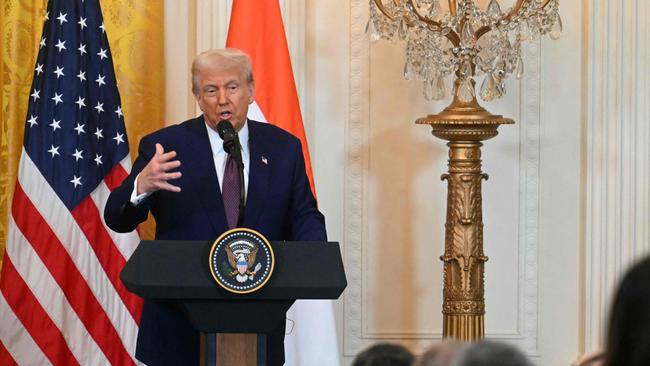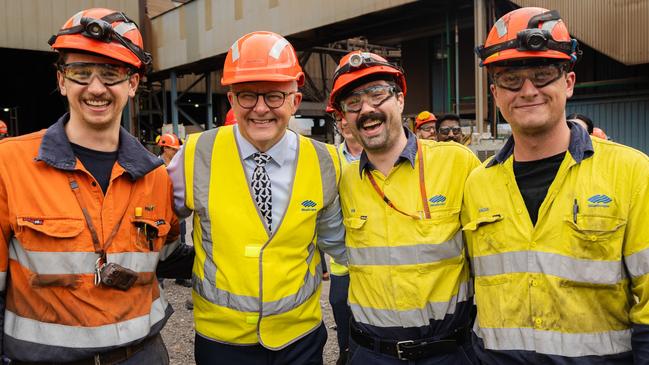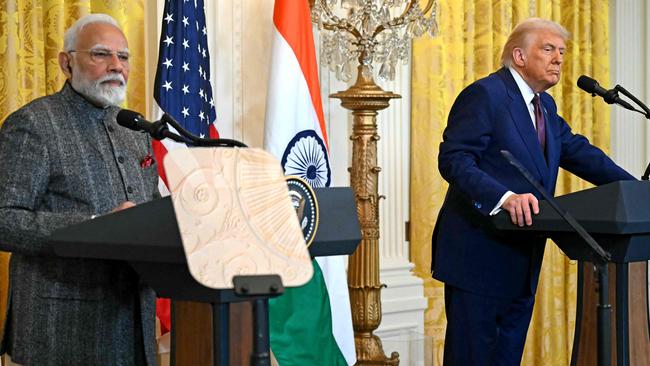GST puts Trump tariff target on Australia as trade war heats up
Mark Vaile, the man who negotiated Australia’s 2004 FTA with the US, says Donald Trump’s move to embrace reciprocal tariffs represents a serious challenge to the global system of free trade.

Australia risks being exposed to Donald Trump’s economic assault on countries with consumption taxes, as the architect of the two nations’ trade deal warns the White House’s new round of reciprocal tariffs could result in higher prices and more government subsidies to keep industries alive.
In his latest bid to reshape global trade, Mr Trump on Thursday (Friday AEDT) signed a memorandum instructing US federal agencies to determine how US tariffs could be adjusted to counteract the treatment of American products by duties, taxes and subsidies abroad.
As Indian Prime Minister Narendra Modi’s visit to the White House left Anthony Albanese as the last Quad leader not to have met Mr Trump in Washington since his return to power, the Prime Minister suggested that the nation would be safe from Mr Trump’s latest trade moves.
“Australia has zero tariffs on US goods coming into Australia,” Mr Albanese said during a visit that included steel manufacturer BlueScope Steel’s NSW south coast plant.
“I note that this morning there has been a statement about reciprocal tariffs. Well Australia has none on the US. We have a free-trade agreement.”
While the free trade agreement between Australia and the US has resulted in the elimination of almost all tariffs between the two countries, the Trump administration said it would specifically target so-called ‘value-added taxes’, putting Australia’s GST in the firing line.
“Australia could be caught up because of our 10 per cent GST,” AMP chief economist Shane Oliver said.
Government sources were confident the GST wouldn’t be at the top of Mr Trump’s trade assault in the event consumption taxes were ultimately targeted, but were cautious about the impact of the retaliatory measures on Australia’s other major trading partners.
That view was shared by John Kunkel, a senior economics adviser at Sydney University’s United States Study Centre, who claimed the potential impact on Australia’s exports was “not huge” but warned of a spillover effect from other countries.
“It’s really the second and third-round effects that will keep Canberra awake at night,” Dr Kunkel said.
Pointing to Mr Trump’s pledge to deliver substantial corporate and income tax cuts that are expected to add billions to the US’ budget deficit, he said: “What’s becoming clear though is there is some implicit revenue target that’s sitting behind this process.”
Mark Vaile, the former trade minister and Nationals deputy prime minister who negotiated the 2004 free trade agreement with the Bush administration, warned that Mr Trump’s move could lead to global upheaval. “The way that we’ve been doing things for the last 40 years is changing,” he said.
“If there’s retaliation or reciprocity, more consumers are paying more. If you look at the major manufacturing bases across the world – and this has been a lot about China as well – all the American manufacturing companies who have established manufacturing bases are going to leave and come home – well some might.”

Mr Vaile, now Whitehaven Coal chairman, said there would have to be “some element of public sector support” for inefficient industries as a result of Mr Trump’s tariffs policy.
Opponents of Mr Trump’s trade agenda said the levying of retaliatory tariffs on countries that imposed consumption taxes made little sense.
Australian Chamber of Commerce and Industry chief executive Andrew McKellar said: “Our GST is applied in a non-discriminatory manner. It applies equally to goods and services Australian consumers buy irrespective of whether they’re produced domestically or overseas.”
Without further details, Mr McKellar said Mr Trump’s trade threat was “very hard to quantify” but risked having a far greater impact than the duties the President had foreshadowed on steel and aluminium imports.
According to the presidential order, the US trade representative and Commerce Department will be tasked with determining the tariff and non-tariff trade barriers levied against US exporters by individual trading partners, reporting back to Mr Trump by April 1. Once that information has been garnered, the administration will then attempt to calculate the value of US exports that have been diverted as a result of the foreign trade barriers and subsequently devise a new tariff rate to reflect that trade volume.

Mr Trump on Thursday also warned that BRICS countries – India, Russia, Brazil, China and South Africa – would be hit with a 100 per tariff if they advanced plans for their own currency.
Mr Modi’s visit to Washington and Japanese Prime Minister Shigeru Ishiba’s recent trip leave Mr Albanese the only member of the Quad not to go to the White House since Mr Trump started his second term last month.
Amid growing pressure for Mr Albanese to meet Mr Trump in person over the steel and aluminium tariffs, opposition trade spokesman Kevin Hogan said the Labor leader should be prioritising a face-to-face encounter with the US president to protect Australian industries.



To join the conversation, please log in. Don't have an account? Register
Join the conversation, you are commenting as Logout